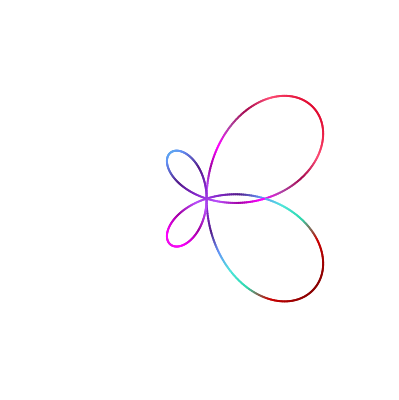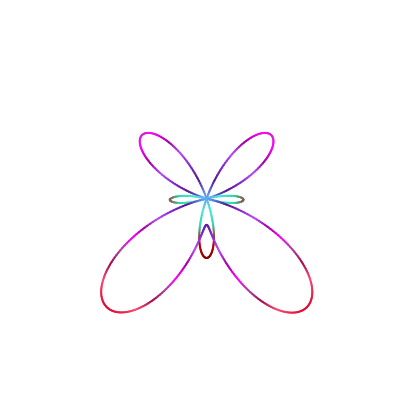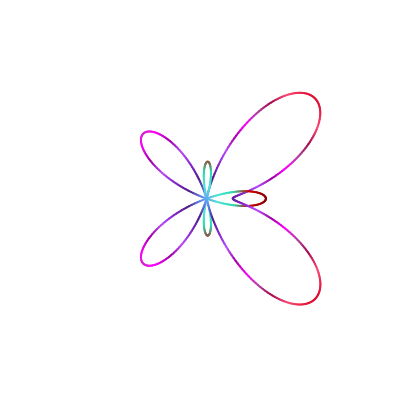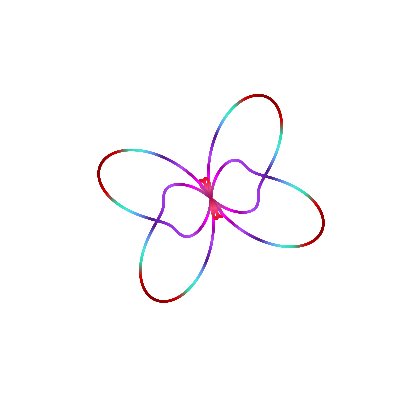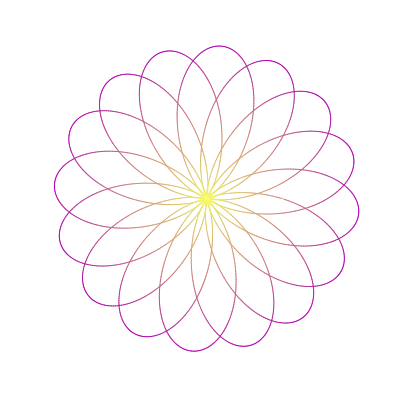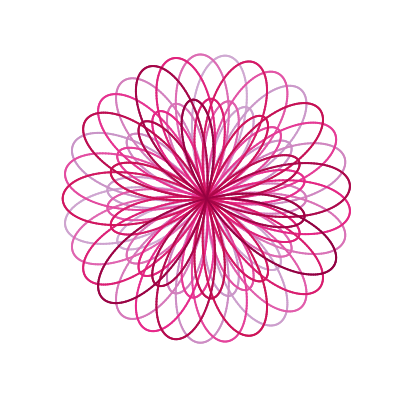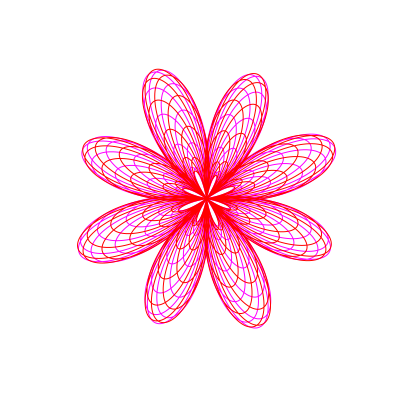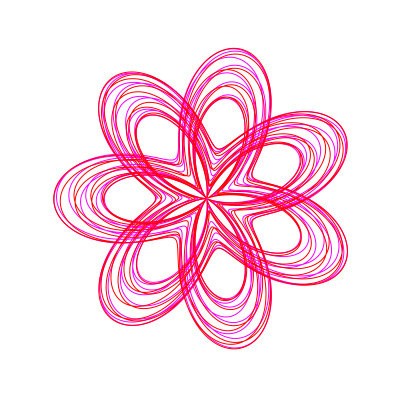|
### A Pluto.jl notebook ### |
|
# v0.19.40 |
|
|
|
using Markdown |
|
using InteractiveUtils |
|
|
|
# This Pluto notebook uses @bind for interactivity. When running this notebook outside of Pluto, the following 'mock version' of @bind gives bound variables a default value (instead of an error). |
|
macro bind(def, element) |
|
quote |
|
local iv = try Base.loaded_modules[Base.PkgId(Base.UUID("6e696c72-6542-2067-7265-42206c756150"), "AbstractPlutoDingetjes")].Bonds.initial_value catch; b -> missing; end |
|
local el = $(esc(element)) |
|
global $(esc(def)) = Core.applicable(Base.get, el) ? Base.get(el) : iv(el) |
|
el |
|
end |
|
end |
|
|
|
# ╔═╡ b524c16c-db16-11ee-1ed3-915f24a7ee51 |
|
using Plots |
|
|
|
# ╔═╡ 735b6f78-1040-4186-895d-cdfd2bdf04c3 |
|
using PlutoUI |
|
|
|
# ╔═╡ a932a413-4b96-44a8-9cd9-e8a37ad6f67a |
|
using ColorSchemes |
|
|
|
# ╔═╡ 6704a128-c9ed-4cbc-a4a0-1c788a7108e7 |
|
md""" |
|
# Butterflies and Roses with Julia |
|
""" |
|
|
|
# ╔═╡ ba3041cc-fdd2-4652-9cd7-f0f26fddf4f2 |
|
md""" |
|
I recently came across [this tumblr post by Mathhombre](https://www.tumblr.com/mathhombre/742682152620130304/butterfly-curves) in which he had shared some beautiful plots he generated using Geogebra. Since it has been so long since I've tried anything with Julia, I thought of recreating some of those plots using Julia. Hence, this post. |
|
""" |
|
|
|
# ╔═╡ 8de9d895-1064-45a5-9098-94b9ab0c2c2c |
|
# plotly() |
|
gr() |
|
|
|
# ╔═╡ 90c84cfb-cead-4abc-a748-8e8167359808 |
|
md"### Butterflies" |
|
|
|
# ╔═╡ 45f4d10a-7612-4609-8174-a969ca7a14cf |
|
md"These plots are originally attributed to [Daniel Mentrard](https://www.geogebra.org/u/daniel+mentrard). He has a large collections of math geogebra projects. One of them is to plot butterflies using polar curves. It is an easy task to reproduce them in Julia. Refer to the r(θ) formula in the Julia code to find the corresponding equation for each of these plots." |
|
|
|
# ╔═╡ 133d4acf-4ea9-43a6-997f-9accc59efb28 |
|
md"#### Butterfly #1" |
|
|
|
# ╔═╡ 253e2768-156b-4a0a-b904-e7f4ebaf8f42 |
|
let |
|
r(θ) = 5sin(2θ) + 3cos(θ) |
|
rval = r.(0:0.01:2π) |
|
p = plot(r, 0:0.01:2π, |
|
proj=:polar, legend=false, linewidth=2, grid=:none, showaxis=false, |
|
linez=rval, c=:dracula, |
|
background_color = :transparent, size=(400,400)) |
|
# savefig(p, "butterfly_1.png"); |
|
end |
|
|
|
# ╔═╡ 4a30b065-db2f-4337-a04a-c71d1acc5cc4 |
|
md"#### Butterfly #2" |
|
|
|
# ╔═╡ dd7f680f-95a5-4e52-a9c6-5d08c36f70cb |
|
let |
|
r1(θ) = (sin(5θ) + 3cos(θ)) |
|
r2(θ) = (sin(5θ) - 3cos(θ)) |
|
r1val = r1.(0:0.01:2π) |
|
r2val = r2.(0:0.01:2π) |
|
p = plot(r1, 0:0.01:2π, proj=:polar, legend=false, linewidth=2, |
|
grid=:none, showaxis=false, |
|
linez=r1val, c=:dracula, |
|
background_color = :transparent, size=(400,400)); |
|
plot!(p, r2, 0:0.01:2π, proj=:polar, legend=false, linewidth=2, |
|
grid=:none, showaxis=false, |
|
linez=r2val, c=:dracula, |
|
background_color = :transparent, size=(400,400)) |
|
# savefig(p, "butterfly_2.png"); |
|
end |
|
|
|
# ╔═╡ cb728488-5688-471a-aae2-27a5ec28c3dc |
|
md"#### Butterfly #3" |
|
|
|
# ╔═╡ 33efa3eb-ee7f-470c-88c8-60d08d4f494c |
|
let |
|
r1(θ) = 3cos(θ) + sin(7θ) |
|
r2(θ) = -3cos(θ) + sin(7θ) |
|
r1val = r1.(0:0.01:2π) |
|
r2val = r2.(0:0.01:2π) |
|
p = plot(r1, 0:0.01:2π, proj=:polar, legend=false, linewidth=2, |
|
grid=:none, showaxis=false, |
|
linez=r1val, c=:dracula, |
|
background_color = :transparent, size=(400,400)); |
|
plot!(p, r2, 0:0.01:2π, proj=:polar, legend=false, linewidth=2, |
|
grid=:none, showaxis=false, |
|
linez=r2val, c=:dracula, |
|
background_color = :transparent, size=(400,400)) |
|
# savefig(p, "butterfly_3.png"); |
|
end |
|
|
|
# ╔═╡ 0c67ae79-2610-4195-9510-68a25cddec81 |
|
md"#### Butterfly #4" |
|
|
|
# ╔═╡ 76184113-ea5f-488e-bcb9-3e2b0a4a3158 |
|
let |
|
r(θ) = 2sin(2θ)+2cos(0.5θ) |
|
rval = r.(0:0.01:4π) |
|
p = plot(r, 0:0.01:4π, |
|
proj=:polar, legend=false, linewidth=2, grid=:none, showaxis=false, |
|
linez=rval, c=:dracula, |
|
background_color = :transparent, size=(400,400)) |
|
# savefig(p, "butterfly_4.png"); |
|
end |
|
|
|
# ╔═╡ d354b029-cbf0-4b0e-aceb-9dfbc829ee20 |
|
md"#### Butterfly #5" |
|
|
|
# ╔═╡ 88e26d47-7790-4552-b039-ffbdac93cdae |
|
let |
|
r(θ) = exp(-sin(θ)) - 2cos(4θ) + (sin((2θ-π)/24)^4) |
|
rval = r.(0:0.01:2π) |
|
plot(r, 0:0.01:2π, |
|
proj=:polar, legend=false, linewidth=2, grid=:none, showaxis=false, |
|
linez=rval, c=:dracula, |
|
background_color = :transparent, size=(400,400)) |
|
# savefig("butterfly_5.png") |
|
end |
|
|
|
# ╔═╡ 7d39f3d2-2960-4708-842f-365e2a0b07b3 |
|
md"#### Buttterfly #6" |
|
|
|
# ╔═╡ 1b843c00-ab15-4d2a-865c-639231f5ec3e |
|
let |
|
r(θ) = 1.6 + 1.1cos(2θ) + (sin(5θ)^3) |
|
rval = r.(0:0.01:2π) |
|
plot(r, 0:0.01:2π, |
|
proj=:polar, legend=false, linewidth=2, grid=:none, showaxis=false, |
|
linez=rval, c=:dracula, |
|
background_color = :transparent, size=(400,400)) |
|
# savefig("butterfly_6.png") |
|
end |
|
|
|
# ╔═╡ 56dedd44-4811-41b9-8a5a-5431dceb6b1e |
|
md"#### Butterfly #7" |
|
|
|
# ╔═╡ 30f92721-754a-4bc3-8df8-409fd756393d |
|
let |
|
r(θ) = exp(sin(θ)-2cos(4θ)) |
|
rval = r.(0:0.01:2π) |
|
plot(r, 0:0.01:2π, |
|
proj=:polar, legend=false, linewidth=2, grid=:none, showaxis=false, |
|
linez=rval, c=:dracula, |
|
background_color = :transparent, size=(400,400)) |
|
# savefig("butterfly_7.png") |
|
end |
|
|
|
# ╔═╡ d55c3dcc-6354-4246-955c-9b8802513038 |
|
md"#### Butterfly #8" |
|
|
|
# ╔═╡ 6d754c24-3fb3-4574-bc77-fa7c324f738a |
|
let |
|
r(θ) = exp(cos(θ)) - 2cos(4θ) + (sin(θ/12)^7) |
|
rval = r.(0:0.01:2π) |
|
plot(r, 0:0.01:2π, |
|
proj=:polar, legend=false, linewidth=2, grid=:none, showaxis=false, |
|
linez=rval, c=:dracula, |
|
background_color = :transparent, size=(400,400)) |
|
# savefig("butterfly_8.png") |
|
end |
|
|
|
# ╔═╡ 803fb40f-036d-4b37-ad22-8a41871cf7eb |
|
md"#### Butterfly #9" |
|
|
|
# ╔═╡ 340eac27-b7d0-414d-97e6-eeeefec69e15 |
|
md"The following butterfly is attributed to mathhombre from tumblr." |
|
|
|
# ╔═╡ c44b6d2f-bfe4-41e4-a772-33299b760d74 |
|
let |
|
a = -2 |
|
b = 2 |
|
c = 1 |
|
d = 4 |
|
K = -2.8 |
|
r1(θ) = a*sin(b*θ) + c*sin(d*θ) + K |
|
r2(θ) = a*cos(b*θ) + c*sin(d*θ) + K |
|
|
|
r1val = r1.(0:0.01:20π) |
|
r2val = r2.(0:0.01:20π) |
|
p = plot(r1, 0:0.01:20π, proj=:polar, legend=false, linewidth=2, |
|
grid=:none, showaxis=false, lims=(-1,4), |
|
linez=r1val, c=:dracula, |
|
background_color = :transparent, size=(400,400)); |
|
plot!(p, r2, 0:0.01:20π, proj=:polar, legend=false, linewidth=2, |
|
grid=:none, showaxis=false, lims=(-1,4), |
|
linez=r2val, c=:dracula,aspectratio=:equal, |
|
background_color = :transparent, size=(400,400)) |
|
# savefig("butterfly_9.png") |
|
end |
|
|
|
# ╔═╡ ce4e7a69-d2f8-4b51-8989-52a9983fd178 |
|
md"## Roses" |
|
|
|
# ╔═╡ 24954f47-43b0-44c6-b4b0-9735f9a8f951 |
|
md"""While plotting the buttefly wasn't difficult, plotting the roses are even easier, thanks to `Pluto.jl`'s support for HTML slider objects being binded to variable. Hence, the equations, |
|
```math |
|
r_1(\theta) = a\sin(b\theta) + csin(d\theta) + K |
|
``` |
|
```math |
|
r_2(\theta) = a\cos(b\theta) + csin(d\theta) + K |
|
``` |
|
with parameters a,b,c,d,K were easier to set. Here are some beautiful flowers rendered with Julia and gr plot backend.""" |
|
|
|
# ╔═╡ 49cc8a36-2df8-4ad8-b96c-2d85f9061e36 |
|
md"#### Rose #1" |
|
|
|
# ╔═╡ 230faca2-f5fe-4d03-8fe3-f88e3fd33921 |
|
let |
|
r(θ) = 4sin(-3.2θ) + 3.9 |
|
rval = r.(0:0.01:10π) |
|
plot(r, 0:0.01:10π, proj= :polar, legend=false,linewidth=1, |
|
mode="lines", axis=false, grid=:none, |
|
aspectratio=:equal, lims=:auto, |
|
linez=rval, |
|
c=cgrad(:buda,rev=true), |
|
background_color = :transparent, size=(400,400)) |
|
# savefig("rose_1.png") |
|
end |
|
|
|
# ╔═╡ 5a6af14a-69e3-4806-9a4d-e5c73df1340b |
|
md"#### Rose #2" |
|
|
|
# ╔═╡ 3a2fd51a-b21c-4b43-99de-310806b1fedc |
|
let |
|
r(θ) = 3.3sin(3.3θ) + 0.6 |
|
rval = r.(0:0.01:30π) |
|
plot(r, 0:0.01:30π, |
|
proj=:polar, legend=false, linewidth=2, grid=:none, showaxis=false, |
|
linez=range(minimum(rval),stop=maximum(rval),length=length(rval)), c=:PuRd_8, |
|
background_color = :transparent, size=(400,400)) |
|
# savefig("rose_2.png") |
|
end |
|
|
|
# ╔═╡ 18f752ed-6f37-4739-a212-85b3d2e86224 |
|
md"#### Rose #3" |
|
|
|
# ╔═╡ f46931aa-16a9-423d-97d2-116846272722 |
|
let |
|
a = -2 |
|
b = 2.9 |
|
c = 3 |
|
d = 4 |
|
K = 0 |
|
r1(θ) = a*sin(b*θ) + c*sin(d*θ) + K |
|
r2(θ) = a*cos(b*θ) + c*sin(d*θ) + K |
|
r1val = r1.(0:0.01:20π) |
|
r2val = r2.(0:0.01:20π) |
|
p = plot(r1, 0:0.01:20π, proj=:polar, legend=false, linewidth=1, |
|
grid=:none, showaxis=false, |
|
c=:spring,aspectratio=:equal, |
|
background_color = :transparent, size=(400,400)); |
|
plot!(p, r2, 0:0.01:20π, proj=:polar, legend=false, linewidth=1, |
|
grid=:none, showaxis=false, |
|
c=:red,aspectratio=:equal, |
|
background_color = :transparent, size=(400,400)) |
|
# savefig("rose_3.png") |
|
end |
|
|
|
# ╔═╡ 49aa2595-d54b-4dc7-8783-89a399f585ed |
|
md"#### Rose #4" |
|
|
|
# ╔═╡ adf491bb-a90c-48db-bd62-0f8a13e919b2 |
|
let |
|
a = -1 |
|
b = 0.777 |
|
c = 2 |
|
d = 3.5 |
|
K = 3. |
|
r1(θ) = a*sin(b*θ) + c*sin(d*θ) + K |
|
r2(θ) = a*cos(b*θ) + c*sin(d*θ) + K |
|
theta = 0:0.01:33π |
|
r1val = r1.(theta) |
|
r2val = r2.(theta) |
|
p = plot(r1, theta, proj=:polar, legend=false, linewidth=1, |
|
grid=:none, showaxis=false, |
|
c=:spring,aspectratio=:equal, |
|
background_color = :transparent, size=(400,400)); |
|
plot!(p, r2, theta, proj=:polar, legend=false, linewidth=1, |
|
grid=:none, showaxis=false, |
|
c=:red,aspectratio=:equal, |
|
background_color = :transparent, size=(400,400)) |
|
# savefig("rose_4.png") |
|
end |
|
|
|
# ╔═╡ 4451158f-b873-43f1-bfa4-2dc710f3ac6a |
|
md"""#### Rose #∞ |
|
|
|
The following sliders (needs Pluto.jl) can be used to generate different flowers based on the parameters. You can try it out generate multiple unique ones!""" |
|
|
|
# ╔═╡ e073c55f-7f61-4a7a-9c37-f125a289cadc |
|
@bind a Slider(-4:0.1:4, default=-2, show_value=true) |
|
|
|
# ╔═╡ e7f8ec30-c98f-4d80-8198-66e54ee39c94 |
|
@bind b Slider(-4:0.1:4, default=2, show_value=true) |
|
|
|
# ╔═╡ 02576584-c168-4d50-9f28-7076f43754a5 |
|
@bind c Slider(-4:0.1:4, default=2, show_value=true) |
|
|
|
# ╔═╡ aa752202-aa11-4981-b59f-4b10eca7f14e |
|
@bind d Slider(-4:0.1:4, default=2, show_value=true) |
|
|
|
# ╔═╡ f50caffc-d98b-483c-9ba0-f412ac2039c1 |
|
@bind K Slider(-4:0.1:4, default=-3.5, show_value=true) |
|
|
|
# ╔═╡ 2c6d2853-9aa6-4854-a05d-8ef318102458 |
|
let |
|
theta = 0:0.01:10π |
|
r₁(θ) = a*sin(b*θ) + c*sin(d*θ) + K |
|
r₂(θ) = a*cos(b*θ) + c*sin(d*θ) + K |
|
r1val = r₁.(theta) |
|
r2val = r₂.(theta) |
|
p = plot(r₁, theta, proj= :polar, legend=false,linewidth=1, |
|
mode="lines", axis=false, grid=:none, |
|
aspectratio=:equal, lims=:auto, |
|
linez=r1val, |
|
c=cgrad(:buda,rev=true)) |
|
plot!(p, r₂, theta, proj= :polar, legend=false,linewidth=1, mode="lines", |
|
aspectratio=:equal, axis=false, grid=:none, background_color = :transparent, |
|
linez=r2val, |
|
c=:twilight) |
|
end |
|
|
|
# ╔═╡ f08d5ac3-9a6c-409a-a981-a94a980d061e |
|
md"Further, the colorschemes I've used are all selected from the catalogue in [Julia plot color schemes](https://docs.juliaplots.org/latest/generated/colorschemes/#scientific) or [Named colors](https://juliagraphics.github.io/Colors.jl/stable/namedcolors/). I also tried using plotly backend but it was having some issue. Hence, I am using GR backend. " |
|
|
|
# ╔═╡ 00000000-0000-0000-0000-000000000001 |
|
PLUTO_PROJECT_TOML_CONTENTS = """ |
|
[deps] |
|
ColorSchemes = "35d6a980-a343-548e-a6ea-1d62b119f2f4" |
|
Plots = "91a5bcdd-55d7-5caf-9e0b-520d859cae80" |
|
PlutoUI = "7f904dfe-b85e-4ff6-b463-dae2292396a8" |
|
|
|
[compat] |
|
ColorSchemes = "~3.24.0" |
|
Plots = "~1.39.0" |
|
PlutoUI = "~0.7.58" |
|
""" |
|
|
|
# ╔═╡ 00000000-0000-0000-0000-000000000002 |
|
PLUTO_MANIFEST_TOML_CONTENTS = """ |
|
# This file is machine-generated - editing it directly is not advised |
|
|
|
julia_version = "1.9.3" |
|
manifest_format = "2.0" |
|
project_hash = "e7dbf2e495bbe3f262c8cbf2e07b9cb7d960cc48" |
|
|
|
[[deps.AbstractPlutoDingetjes]] |
|
deps = ["Pkg"] |
|
git-tree-sha1 = "0f748c81756f2e5e6854298f11ad8b2dfae6911a" |
|
uuid = "6e696c72-6542-2067-7265-42206c756150" |
|
version = "1.3.0" |
|
|
|
[[deps.ArgTools]] |
|
uuid = "0dad84c5-d112-42e6-8d28-ef12dabb789f" |
|
version = "1.1.1" |
|
|
|
[[deps.Artifacts]] |
|
uuid = "56f22d72-fd6d-98f1-02f0-08ddc0907c33" |
|
|
|
[[deps.Base64]] |
|
uuid = "2a0f44e3-6c83-55bd-87e4-b1978d98bd5f" |
|
|
|
[[deps.BitFlags]] |
|
git-tree-sha1 = "2dc09997850d68179b69dafb58ae806167a32b1b" |
|
uuid = "d1d4a3ce-64b1-5f1a-9ba4-7e7e69966f35" |
|
version = "0.1.8" |
|
|
|
[[deps.Bzip2_jll]] |
|
deps = ["Artifacts", "JLLWrappers", "Libdl", "Pkg"] |
|
git-tree-sha1 = "9e2a6b69137e6969bab0152632dcb3bc108c8bdd" |
|
uuid = "6e34b625-4abd-537c-b88f-471c36dfa7a0" |
|
version = "1.0.8+1" |
|
|
|
[[deps.Cairo_jll]] |
|
deps = ["Artifacts", "Bzip2_jll", "CompilerSupportLibraries_jll", "Fontconfig_jll", "FreeType2_jll", "Glib_jll", "JLLWrappers", "LZO_jll", "Libdl", "Pixman_jll", "Pkg", "Xorg_libXext_jll", "Xorg_libXrender_jll", "Zlib_jll", "libpng_jll"] |
|
git-tree-sha1 = "4b859a208b2397a7a623a03449e4636bdb17bcf2" |
|
uuid = "83423d85-b0ee-5818-9007-b63ccbeb887a" |
|
version = "1.16.1+1" |
|
|
|
[[deps.CodecZlib]] |
|
deps = ["TranscodingStreams", "Zlib_jll"] |
|
git-tree-sha1 = "59939d8a997469ee05c4b4944560a820f9ba0d73" |
|
uuid = "944b1d66-785c-5afd-91f1-9de20f533193" |
|
version = "0.7.4" |
|
|
|
[[deps.ColorSchemes]] |
|
deps = ["ColorTypes", "ColorVectorSpace", "Colors", "FixedPointNumbers", "PrecompileTools", "Random"] |
|
git-tree-sha1 = "67c1f244b991cad9b0aa4b7540fb758c2488b129" |
|
uuid = "35d6a980-a343-548e-a6ea-1d62b119f2f4" |
|
version = "3.24.0" |
|
|
|
[[deps.ColorTypes]] |
|
deps = ["FixedPointNumbers", "Random"] |
|
git-tree-sha1 = "eb7f0f8307f71fac7c606984ea5fb2817275d6e4" |
|
uuid = "3da002f7-5984-5a60-b8a6-cbb66c0b333f" |
|
version = "0.11.4" |
|
|
|
[[deps.ColorVectorSpace]] |
|
deps = ["ColorTypes", "FixedPointNumbers", "LinearAlgebra", "Requires", "Statistics", "TensorCore"] |
|
git-tree-sha1 = "a1f44953f2382ebb937d60dafbe2deea4bd23249" |
|
uuid = "c3611d14-8923-5661-9e6a-0046d554d3a4" |
|
version = "0.10.0" |
|
|
|
[deps.ColorVectorSpace.extensions] |
|
SpecialFunctionsExt = "SpecialFunctions" |
|
|
|
[deps.ColorVectorSpace.weakdeps] |
|
SpecialFunctions = "276daf66-3868-5448-9aa4-cd146d93841b" |
|
|
|
[[deps.Colors]] |
|
deps = ["ColorTypes", "FixedPointNumbers", "Reexport"] |
|
git-tree-sha1 = "fc08e5930ee9a4e03f84bfb5211cb54e7769758a" |
|
uuid = "5ae59095-9a9b-59fe-a467-6f913c188581" |
|
version = "0.12.10" |
|
|
|
[[deps.Compat]] |
|
deps = ["TOML", "UUIDs"] |
|
git-tree-sha1 = "c955881e3c981181362ae4088b35995446298b80" |
|
uuid = "34da2185-b29b-5c13-b0c7-acf172513d20" |
|
version = "4.14.0" |
|
weakdeps = ["Dates", "LinearAlgebra"] |
|
|
|
[deps.Compat.extensions] |
|
CompatLinearAlgebraExt = "LinearAlgebra" |
|
|
|
[[deps.CompilerSupportLibraries_jll]] |
|
deps = ["Artifacts", "Libdl"] |
|
uuid = "e66e0078-7015-5450-92f7-15fbd957f2ae" |
|
version = "1.0.5+0" |
|
|
|
[[deps.ConcurrentUtilities]] |
|
deps = ["Serialization", "Sockets"] |
|
git-tree-sha1 = "9c4708e3ed2b799e6124b5673a712dda0b596a9b" |
|
uuid = "f0e56b4a-5159-44fe-b623-3e5288b988bb" |
|
version = "2.3.1" |
|
|
|
[[deps.Contour]] |
|
git-tree-sha1 = "d05d9e7b7aedff4e5b51a029dced05cfb6125781" |
|
uuid = "d38c429a-6771-53c6-b99e-75d170b6e991" |
|
version = "0.6.2" |
|
|
|
[[deps.DataAPI]] |
|
git-tree-sha1 = "abe83f3a2f1b857aac70ef8b269080af17764bbe" |
|
uuid = "9a962f9c-6df0-11e9-0e5d-c546b8b5ee8a" |
|
version = "1.16.0" |
|
|
|
[[deps.DataStructures]] |
|
deps = ["Compat", "InteractiveUtils", "OrderedCollections"] |
|
git-tree-sha1 = "0f4b5d62a88d8f59003e43c25a8a90de9eb76317" |
|
uuid = "864edb3b-99cc-5e75-8d2d-829cb0a9cfe8" |
|
version = "0.18.18" |
|
|
|
[[deps.Dates]] |
|
deps = ["Printf"] |
|
uuid = "ade2ca70-3891-5945-98fb-dc099432e06a" |
|
|
|
[[deps.DelimitedFiles]] |
|
deps = ["Mmap"] |
|
git-tree-sha1 = "9e2f36d3c96a820c678f2f1f1782582fcf685bae" |
|
uuid = "8bb1440f-4735-579b-a4ab-409b98df4dab" |
|
version = "1.9.1" |
|
|
|
[[deps.DocStringExtensions]] |
|
deps = ["LibGit2"] |
|
git-tree-sha1 = "2fb1e02f2b635d0845df5d7c167fec4dd739b00d" |
|
uuid = "ffbed154-4ef7-542d-bbb7-c09d3a79fcae" |
|
version = "0.9.3" |
|
|
|
[[deps.Downloads]] |
|
deps = ["ArgTools", "FileWatching", "LibCURL", "NetworkOptions"] |
|
uuid = "f43a241f-c20a-4ad4-852c-f6b1247861c6" |
|
version = "1.6.0" |
|
|
|
[[deps.EpollShim_jll]] |
|
deps = ["Artifacts", "JLLWrappers", "Libdl"] |
|
git-tree-sha1 = "8e9441ee83492030ace98f9789a654a6d0b1f643" |
|
uuid = "2702e6a9-849d-5ed8-8c21-79e8b8f9ee43" |
|
version = "0.0.20230411+0" |
|
|
|
[[deps.ExceptionUnwrapping]] |
|
deps = ["Test"] |
|
git-tree-sha1 = "dcb08a0d93ec0b1cdc4af184b26b591e9695423a" |
|
uuid = "460bff9d-24e4-43bc-9d9f-a8973cb893f4" |
|
version = "0.1.10" |
|
|
|
[[deps.Expat_jll]] |
|
deps = ["Artifacts", "JLLWrappers", "Libdl"] |
|
git-tree-sha1 = "4558ab818dcceaab612d1bb8c19cee87eda2b83c" |
|
uuid = "2e619515-83b5-522b-bb60-26c02a35a201" |
|
version = "2.5.0+0" |
|
|
|
[[deps.FFMPEG]] |
|
deps = ["FFMPEG_jll"] |
|
git-tree-sha1 = "b57e3acbe22f8484b4b5ff66a7499717fe1a9cc8" |
|
uuid = "c87230d0-a227-11e9-1b43-d7ebe4e7570a" |
|
version = "0.4.1" |
|
|
|
[[deps.FFMPEG_jll]] |
|
deps = ["Artifacts", "Bzip2_jll", "FreeType2_jll", "FriBidi_jll", "JLLWrappers", "LAME_jll", "Libdl", "Ogg_jll", "OpenSSL_jll", "Opus_jll", "PCRE2_jll", "Zlib_jll", "libaom_jll", "libass_jll", "libfdk_aac_jll", "libvorbis_jll", "x264_jll", "x265_jll"] |
|
git-tree-sha1 = "466d45dc38e15794ec7d5d63ec03d776a9aff36e" |
|
uuid = "b22a6f82-2f65-5046-a5b2-351ab43fb4e5" |
|
version = "4.4.4+1" |
|
|
|
[[deps.FileWatching]] |
|
uuid = "7b1f6079-737a-58dc-b8bc-7a2ca5c1b5ee" |
|
|
|
[[deps.FixedPointNumbers]] |
|
deps = ["Statistics"] |
|
git-tree-sha1 = "335bfdceacc84c5cdf16aadc768aa5ddfc5383cc" |
|
uuid = "53c48c17-4a7d-5ca2-90c5-79b7896eea93" |
|
version = "0.8.4" |
|
|
|
[[deps.Fontconfig_jll]] |
|
deps = ["Artifacts", "Bzip2_jll", "Expat_jll", "FreeType2_jll", "JLLWrappers", "Libdl", "Libuuid_jll", "Pkg", "Zlib_jll"] |
|
git-tree-sha1 = "21efd19106a55620a188615da6d3d06cd7f6ee03" |
|
uuid = "a3f928ae-7b40-5064-980b-68af3947d34b" |
|
version = "2.13.93+0" |
|
|
|
[[deps.Format]] |
|
git-tree-sha1 = "f3cf88025f6d03c194d73f5d13fee9004a108329" |
|
uuid = "1fa38f19-a742-5d3f-a2b9-30dd87b9d5f8" |
|
version = "1.3.6" |
|
|
|
[[deps.FreeType2_jll]] |
|
deps = ["Artifacts", "Bzip2_jll", "JLLWrappers", "Libdl", "Zlib_jll"] |
|
git-tree-sha1 = "d8db6a5a2fe1381c1ea4ef2cab7c69c2de7f9ea0" |
|
uuid = "d7e528f0-a631-5988-bf34-fe36492bcfd7" |
|
version = "2.13.1+0" |
|
|
|
[[deps.FriBidi_jll]] |
|
deps = ["Artifacts", "JLLWrappers", "Libdl", "Pkg"] |
|
git-tree-sha1 = "aa31987c2ba8704e23c6c8ba8a4f769d5d7e4f91" |
|
uuid = "559328eb-81f9-559d-9380-de523a88c83c" |
|
version = "1.0.10+0" |
|
|
|
[[deps.GLFW_jll]] |
|
deps = ["Artifacts", "JLLWrappers", "Libdl", "Libglvnd_jll", "Xorg_libXcursor_jll", "Xorg_libXi_jll", "Xorg_libXinerama_jll", "Xorg_libXrandr_jll"] |
|
git-tree-sha1 = "ff38ba61beff76b8f4acad8ab0c97ef73bb670cb" |
|
uuid = "0656b61e-2033-5cc2-a64a-77c0f6c09b89" |
|
version = "3.3.9+0" |
|
|
|
[[deps.GR]] |
|
deps = ["Artifacts", "Base64", "DelimitedFiles", "Downloads", "GR_jll", "HTTP", "JSON", "Libdl", "LinearAlgebra", "Pkg", "Preferences", "Printf", "Random", "Serialization", "Sockets", "TOML", "Tar", "Test", "UUIDs", "p7zip_jll"] |
|
git-tree-sha1 = "27442171f28c952804dede8ff72828a96f2bfc1f" |
|
uuid = "28b8d3ca-fb5f-59d9-8090-bfdbd6d07a71" |
|
version = "0.72.10" |
|
|
|
[[deps.GR_jll]] |
|
deps = ["Artifacts", "Bzip2_jll", "Cairo_jll", "FFMPEG_jll", "Fontconfig_jll", "FreeType2_jll", "GLFW_jll", "JLLWrappers", "JpegTurbo_jll", "Libdl", "Libtiff_jll", "Pixman_jll", "Qt6Base_jll", "Zlib_jll", "libpng_jll"] |
|
git-tree-sha1 = "025d171a2847f616becc0f84c8dc62fe18f0f6dd" |
|
uuid = "d2c73de3-f751-5644-a686-071e5b155ba9" |
|
version = "0.72.10+0" |
|
|
|
[[deps.Gettext_jll]] |
|
deps = ["Artifacts", "CompilerSupportLibraries_jll", "JLLWrappers", "Libdl", "Libiconv_jll", "Pkg", "XML2_jll"] |
|
git-tree-sha1 = "9b02998aba7bf074d14de89f9d37ca24a1a0b046" |
|
uuid = "78b55507-aeef-58d4-861c-77aaff3498b1" |
|
version = "0.21.0+0" |
|
|
|
[[deps.Glib_jll]] |
|
deps = ["Artifacts", "Gettext_jll", "JLLWrappers", "Libdl", "Libffi_jll", "Libiconv_jll", "Libmount_jll", "PCRE2_jll", "Zlib_jll"] |
|
git-tree-sha1 = "e94c92c7bf4819685eb80186d51c43e71d4afa17" |
|
uuid = "7746bdde-850d-59dc-9ae8-88ece973131d" |
|
version = "2.76.5+0" |
|
|
|
[[deps.Graphite2_jll]] |
|
deps = ["Artifacts", "JLLWrappers", "Libdl", "Pkg"] |
|
git-tree-sha1 = "344bf40dcab1073aca04aa0df4fb092f920e4011" |
|
uuid = "3b182d85-2403-5c21-9c21-1e1f0cc25472" |
|
version = "1.3.14+0" |
|
|
|
[[deps.Grisu]] |
|
git-tree-sha1 = "53bb909d1151e57e2484c3d1b53e19552b887fb2" |
|
uuid = "42e2da0e-8278-4e71-bc24-59509adca0fe" |
|
version = "1.0.2" |
|
|
|
[[deps.HTTP]] |
|
deps = ["Base64", "CodecZlib", "ConcurrentUtilities", "Dates", "ExceptionUnwrapping", "Logging", "LoggingExtras", "MbedTLS", "NetworkOptions", "OpenSSL", "Random", "SimpleBufferStream", "Sockets", "URIs", "UUIDs"] |
|
git-tree-sha1 = "db864f2d91f68a5912937af80327d288ea1f3aee" |
|
uuid = "cd3eb016-35fb-5094-929b-558a96fad6f3" |
|
version = "1.10.3" |
|
|
|
[[deps.HarfBuzz_jll]] |
|
deps = ["Artifacts", "Cairo_jll", "Fontconfig_jll", "FreeType2_jll", "Glib_jll", "Graphite2_jll", "JLLWrappers", "Libdl", "Libffi_jll", "Pkg"] |
|
git-tree-sha1 = "129acf094d168394e80ee1dc4bc06ec835e510a3" |
|
uuid = "2e76f6c2-a576-52d4-95c1-20adfe4de566" |
|
version = "2.8.1+1" |
|
|
|
[[deps.Hyperscript]] |
|
deps = ["Test"] |
|
git-tree-sha1 = "179267cfa5e712760cd43dcae385d7ea90cc25a4" |
|
uuid = "47d2ed2b-36de-50cf-bf87-49c2cf4b8b91" |
|
version = "0.0.5" |
|
|
|
[[deps.HypertextLiteral]] |
|
deps = ["Tricks"] |
|
git-tree-sha1 = "7134810b1afce04bbc1045ca1985fbe81ce17653" |
|
uuid = "ac1192a8-f4b3-4bfe-ba22-af5b92cd3ab2" |
|
version = "0.9.5" |
|
|
|
[[deps.IOCapture]] |
|
deps = ["Logging", "Random"] |
|
git-tree-sha1 = "8b72179abc660bfab5e28472e019392b97d0985c" |
|
uuid = "b5f81e59-6552-4d32-b1f0-c071b021bf89" |
|
version = "0.2.4" |
|
|
|
[[deps.InteractiveUtils]] |
|
deps = ["Markdown"] |
|
uuid = "b77e0a4c-d291-57a0-90e8-8db25a27a240" |
|
|
|
[[deps.IrrationalConstants]] |
|
git-tree-sha1 = "630b497eafcc20001bba38a4651b327dcfc491d2" |
|
uuid = "92d709cd-6900-40b7-9082-c6be49f344b6" |
|
version = "0.2.2" |
|
|
|
[[deps.JLFzf]] |
|
deps = ["Pipe", "REPL", "Random", "fzf_jll"] |
|
git-tree-sha1 = "a53ebe394b71470c7f97c2e7e170d51df21b17af" |
|
uuid = "1019f520-868f-41f5-a6de-eb00f4b6a39c" |
|
version = "0.1.7" |
|
|
|
[[deps.JLLWrappers]] |
|
deps = ["Artifacts", "Preferences"] |
|
git-tree-sha1 = "7e5d6779a1e09a36db2a7b6cff50942a0a7d0fca" |
|
uuid = "692b3bcd-3c85-4b1f-b108-f13ce0eb3210" |
|
version = "1.5.0" |
|
|
|
[[deps.JSON]] |
|
deps = ["Dates", "Mmap", "Parsers", "Unicode"] |
|
git-tree-sha1 = "31e996f0a15c7b280ba9f76636b3ff9e2ae58c9a" |
|
uuid = "682c06a0-de6a-54ab-a142-c8b1cf79cde6" |
|
version = "0.21.4" |
|
|
|
[[deps.JpegTurbo_jll]] |
|
deps = ["Artifacts", "JLLWrappers", "Libdl"] |
|
git-tree-sha1 = "3336abae9a713d2210bb57ab484b1e065edd7d23" |
|
uuid = "aacddb02-875f-59d6-b918-886e6ef4fbf8" |
|
version = "3.0.2+0" |
|
|
|
[[deps.LAME_jll]] |
|
deps = ["Artifacts", "JLLWrappers", "Libdl", "Pkg"] |
|
git-tree-sha1 = "f6250b16881adf048549549fba48b1161acdac8c" |
|
uuid = "c1c5ebd0-6772-5130-a774-d5fcae4a789d" |
|
version = "3.100.1+0" |
|
|
|
[[deps.LERC_jll]] |
|
deps = ["Artifacts", "JLLWrappers", "Libdl", "Pkg"] |
|
git-tree-sha1 = "bf36f528eec6634efc60d7ec062008f171071434" |
|
uuid = "88015f11-f218-50d7-93a8-a6af411a945d" |
|
version = "3.0.0+1" |
|
|
|
[[deps.LLVMOpenMP_jll]] |
|
deps = ["Artifacts", "JLLWrappers", "Libdl"] |
|
git-tree-sha1 = "d986ce2d884d49126836ea94ed5bfb0f12679713" |
|
uuid = "1d63c593-3942-5779-bab2-d838dc0a180e" |
|
version = "15.0.7+0" |
|
|
|
[[deps.LZO_jll]] |
|
deps = ["Artifacts", "JLLWrappers", "Libdl", "Pkg"] |
|
git-tree-sha1 = "e5b909bcf985c5e2605737d2ce278ed791b89be6" |
|
uuid = "dd4b983a-f0e5-5f8d-a1b7-129d4a5fb1ac" |
|
version = "2.10.1+0" |
|
|
|
[[deps.LaTeXStrings]] |
|
git-tree-sha1 = "50901ebc375ed41dbf8058da26f9de442febbbec" |
|
uuid = "b964fa9f-0449-5b57-a5c2-d3ea65f4040f" |
|
version = "1.3.1" |
|
|
|
[[deps.Latexify]] |
|
deps = ["Format", "InteractiveUtils", "LaTeXStrings", "MacroTools", "Markdown", "OrderedCollections", "Requires"] |
|
git-tree-sha1 = "cad560042a7cc108f5a4c24ea1431a9221f22c1b" |
|
uuid = "23fbe1c1-3f47-55db-b15f-69d7ec21a316" |
|
version = "0.16.2" |
|
|
|
[deps.Latexify.extensions] |
|
DataFramesExt = "DataFrames" |
|
SymEngineExt = "SymEngine" |
|
|
|
[deps.Latexify.weakdeps] |
|
DataFrames = "a93c6f00-e57d-5684-b7b6-d8193f3e46c0" |
|
SymEngine = "123dc426-2d89-5057-bbad-38513e3affd8" |
|
|
|
[[deps.LibCURL]] |
|
deps = ["LibCURL_jll", "MozillaCACerts_jll"] |
|
uuid = "b27032c2-a3e7-50c8-80cd-2d36dbcbfd21" |
|
version = "0.6.3" |
|
|
|
[[deps.LibCURL_jll]] |
|
deps = ["Artifacts", "LibSSH2_jll", "Libdl", "MbedTLS_jll", "Zlib_jll", "nghttp2_jll"] |
|
uuid = "deac9b47-8bc7-5906-a0fe-35ac56dc84c0" |
|
version = "7.84.0+0" |
|
|
|
[[deps.LibGit2]] |
|
deps = ["Base64", "NetworkOptions", "Printf", "SHA"] |
|
uuid = "76f85450-5226-5b5a-8eaa-529ad045b433" |
|
|
|
[[deps.LibSSH2_jll]] |
|
deps = ["Artifacts", "Libdl", "MbedTLS_jll"] |
|
uuid = "29816b5a-b9ab-546f-933c-edad1886dfa8" |
|
version = "1.10.2+0" |
|
|
|
[[deps.Libdl]] |
|
uuid = "8f399da3-3557-5675-b5ff-fb832c97cbdb" |
|
|
|
[[deps.Libffi_jll]] |
|
deps = ["Artifacts", "JLLWrappers", "Libdl", "Pkg"] |
|
git-tree-sha1 = "0b4a5d71f3e5200a7dff793393e09dfc2d874290" |
|
uuid = "e9f186c6-92d2-5b65-8a66-fee21dc1b490" |
|
version = "3.2.2+1" |
|
|
|
[[deps.Libgcrypt_jll]] |
|
deps = ["Artifacts", "JLLWrappers", "Libdl", "Libgpg_error_jll", "Pkg"] |
|
git-tree-sha1 = "64613c82a59c120435c067c2b809fc61cf5166ae" |
|
uuid = "d4300ac3-e22c-5743-9152-c294e39db1e4" |
|
version = "1.8.7+0" |
|
|
|
[[deps.Libglvnd_jll]] |
|
deps = ["Artifacts", "JLLWrappers", "Libdl", "Pkg", "Xorg_libX11_jll", "Xorg_libXext_jll"] |
|
git-tree-sha1 = "6f73d1dd803986947b2c750138528a999a6c7733" |
|
uuid = "7e76a0d4-f3c7-5321-8279-8d96eeed0f29" |
|
version = "1.6.0+0" |
|
|
|
[[deps.Libgpg_error_jll]] |
|
deps = ["Artifacts", "JLLWrappers", "Libdl", "Pkg"] |
|
git-tree-sha1 = "c333716e46366857753e273ce6a69ee0945a6db9" |
|
uuid = "7add5ba3-2f88-524e-9cd5-f83b8a55f7b8" |
|
version = "1.42.0+0" |
|
|
|
[[deps.Libiconv_jll]] |
|
deps = ["Artifacts", "JLLWrappers", "Libdl"] |
|
git-tree-sha1 = "f9557a255370125b405568f9767d6d195822a175" |
|
uuid = "94ce4f54-9a6c-5748-9c1c-f9c7231a4531" |
|
version = "1.17.0+0" |
|
|
|
[[deps.Libmount_jll]] |
|
deps = ["Artifacts", "JLLWrappers", "Libdl", "Pkg"] |
|
git-tree-sha1 = "9c30530bf0effd46e15e0fdcf2b8636e78cbbd73" |
|
uuid = "4b2f31a3-9ecc-558c-b454-b3730dcb73e9" |
|
version = "2.35.0+0" |
|
|
|
[[deps.Libtiff_jll]] |
|
deps = ["Artifacts", "JLLWrappers", "JpegTurbo_jll", "LERC_jll", "Libdl", "XZ_jll", "Zlib_jll", "Zstd_jll"] |
|
git-tree-sha1 = "2da088d113af58221c52828a80378e16be7d037a" |
|
uuid = "89763e89-9b03-5906-acba-b20f662cd828" |
|
version = "4.5.1+1" |
|
|
|
[[deps.Libuuid_jll]] |
|
deps = ["Artifacts", "JLLWrappers", "Libdl"] |
|
git-tree-sha1 = "e5edc369a598dfde567269dc6add5812cfa10cd5" |
|
uuid = "38a345b3-de98-5d2b-a5d3-14cd9215e700" |
|
version = "2.39.3+0" |
|
|
|
[[deps.LinearAlgebra]] |
|
deps = ["Libdl", "OpenBLAS_jll", "libblastrampoline_jll"] |
|
uuid = "37e2e46d-f89d-539d-b4ee-838fcccc9c8e" |
|
|
|
[[deps.LogExpFunctions]] |
|
deps = ["DocStringExtensions", "IrrationalConstants", "LinearAlgebra"] |
|
git-tree-sha1 = "18144f3e9cbe9b15b070288eef858f71b291ce37" |
|
uuid = "2ab3a3ac-af41-5b50-aa03-7779005ae688" |
|
version = "0.3.27" |
|
|
|
[deps.LogExpFunctions.extensions] |
|
LogExpFunctionsChainRulesCoreExt = "ChainRulesCore" |
|
LogExpFunctionsChangesOfVariablesExt = "ChangesOfVariables" |
|
LogExpFunctionsInverseFunctionsExt = "InverseFunctions" |
|
|
|
[deps.LogExpFunctions.weakdeps] |
|
ChainRulesCore = "d360d2e6-b24c-11e9-a2a3-2a2ae2dbcce4" |
|
ChangesOfVariables = "9e997f8a-9a97-42d5-a9f1-ce6bfc15e2c0" |
|
InverseFunctions = "3587e190-3f89-42d0-90ee-14403ec27112" |
|
|
|
[[deps.Logging]] |
|
uuid = "56ddb016-857b-54e1-b83d-db4d58db5568" |
|
|
|
[[deps.LoggingExtras]] |
|
deps = ["Dates", "Logging"] |
|
git-tree-sha1 = "c1dd6d7978c12545b4179fb6153b9250c96b0075" |
|
uuid = "e6f89c97-d47a-5376-807f-9c37f3926c36" |
|
version = "1.0.3" |
|
|
|
[[deps.MIMEs]] |
|
git-tree-sha1 = "65f28ad4b594aebe22157d6fac869786a255b7eb" |
|
uuid = "6c6e2e6c-3030-632d-7369-2d6c69616d65" |
|
version = "0.1.4" |
|
|
|
[[deps.MacroTools]] |
|
deps = ["Markdown", "Random"] |
|
git-tree-sha1 = "2fa9ee3e63fd3a4f7a9a4f4744a52f4856de82df" |
|
uuid = "1914dd2f-81c6-5fcd-8719-6d5c9610ff09" |
|
version = "0.5.13" |
|
|
|
[[deps.Markdown]] |
|
deps = ["Base64"] |
|
uuid = "d6f4376e-aef5-505a-96c1-9c027394607a" |
|
|
|
[[deps.MbedTLS]] |
|
deps = ["Dates", "MbedTLS_jll", "MozillaCACerts_jll", "NetworkOptions", "Random", "Sockets"] |
|
git-tree-sha1 = "c067a280ddc25f196b5e7df3877c6b226d390aaf" |
|
uuid = "739be429-bea8-5141-9913-cc70e7f3736d" |
|
version = "1.1.9" |
|
|
|
[[deps.MbedTLS_jll]] |
|
deps = ["Artifacts", "Libdl"] |
|
uuid = "c8ffd9c3-330d-5841-b78e-0817d7145fa1" |
|
version = "2.28.2+0" |
|
|
|
[[deps.Measures]] |
|
git-tree-sha1 = "c13304c81eec1ed3af7fc20e75fb6b26092a1102" |
|
uuid = "442fdcdd-2543-5da2-b0f3-8c86c306513e" |
|
version = "0.3.2" |
|
|
|
[[deps.Missings]] |
|
deps = ["DataAPI"] |
|
git-tree-sha1 = "f66bdc5de519e8f8ae43bdc598782d35a25b1272" |
|
uuid = "e1d29d7a-bbdc-5cf2-9ac0-f12de2c33e28" |
|
version = "1.1.0" |
|
|
|
[[deps.Mmap]] |
|
uuid = "a63ad114-7e13-5084-954f-fe012c677804" |
|
|
|
[[deps.MozillaCACerts_jll]] |
|
uuid = "14a3606d-f60d-562e-9121-12d972cd8159" |
|
version = "2022.10.11" |
|
|
|
[[deps.NaNMath]] |
|
deps = ["OpenLibm_jll"] |
|
git-tree-sha1 = "0877504529a3e5c3343c6f8b4c0381e57e4387e4" |
|
uuid = "77ba4419-2d1f-58cd-9bb1-8ffee604a2e3" |
|
version = "1.0.2" |
|
|
|
[[deps.NetworkOptions]] |
|
uuid = "ca575930-c2e3-43a9-ace4-1e988b2c1908" |
|
version = "1.2.0" |
|
|
|
[[deps.Ogg_jll]] |
|
deps = ["Artifacts", "JLLWrappers", "Libdl", "Pkg"] |
|
git-tree-sha1 = "887579a3eb005446d514ab7aeac5d1d027658b8f" |
|
uuid = "e7412a2a-1a6e-54c0-be00-318e2571c051" |
|
version = "1.3.5+1" |
|
|
|
[[deps.OpenBLAS_jll]] |
|
deps = ["Artifacts", "CompilerSupportLibraries_jll", "Libdl"] |
|
uuid = "4536629a-c528-5b80-bd46-f80d51c5b363" |
|
version = "0.3.21+4" |
|
|
|
[[deps.OpenLibm_jll]] |
|
deps = ["Artifacts", "Libdl"] |
|
uuid = "05823500-19ac-5b8b-9628-191a04bc5112" |
|
version = "0.8.1+0" |
|
|
|
[[deps.OpenSSL]] |
|
deps = ["BitFlags", "Dates", "MozillaCACerts_jll", "OpenSSL_jll", "Sockets"] |
|
git-tree-sha1 = "af81a32750ebc831ee28bdaaba6e1067decef51e" |
|
uuid = "4d8831e6-92b7-49fb-bdf8-b643e874388c" |
|
version = "1.4.2" |
|
|
|
[[deps.OpenSSL_jll]] |
|
deps = ["Artifacts", "JLLWrappers", "Libdl"] |
|
git-tree-sha1 = "60e3045590bd104a16fefb12836c00c0ef8c7f8c" |
|
uuid = "458c3c95-2e84-50aa-8efc-19380b2a3a95" |
|
version = "3.0.13+0" |
|
|
|
[[deps.Opus_jll]] |
|
deps = ["Artifacts", "JLLWrappers", "Libdl", "Pkg"] |
|
git-tree-sha1 = "51a08fb14ec28da2ec7a927c4337e4332c2a4720" |
|
uuid = "91d4177d-7536-5919-b921-800302f37372" |
|
version = "1.3.2+0" |
|
|
|
[[deps.OrderedCollections]] |
|
git-tree-sha1 = "dfdf5519f235516220579f949664f1bf44e741c5" |
|
uuid = "bac558e1-5e72-5ebc-8fee-abe8a469f55d" |
|
version = "1.6.3" |
|
|
|
[[deps.PCRE2_jll]] |
|
deps = ["Artifacts", "Libdl"] |
|
uuid = "efcefdf7-47ab-520b-bdef-62a2eaa19f15" |
|
version = "10.42.0+0" |
|
|
|
[[deps.Parsers]] |
|
deps = ["Dates", "PrecompileTools", "UUIDs"] |
|
git-tree-sha1 = "8489905bcdbcfac64d1daa51ca07c0d8f0283821" |
|
uuid = "69de0a69-1ddd-5017-9359-2bf0b02dc9f0" |
|
version = "2.8.1" |
|
|
|
[[deps.Pipe]] |
|
git-tree-sha1 = "6842804e7867b115ca9de748a0cf6b364523c16d" |
|
uuid = "b98c9c47-44ae-5843-9183-064241ee97a0" |
|
version = "1.3.0" |
|
|
|
[[deps.Pixman_jll]] |
|
deps = ["Artifacts", "CompilerSupportLibraries_jll", "JLLWrappers", "LLVMOpenMP_jll", "Libdl"] |
|
git-tree-sha1 = "64779bc4c9784fee475689a1752ef4d5747c5e87" |
|
uuid = "30392449-352a-5448-841d-b1acce4e97dc" |
|
version = "0.42.2+0" |
|
|
|
[[deps.Pkg]] |
|
deps = ["Artifacts", "Dates", "Downloads", "FileWatching", "LibGit2", "Libdl", "Logging", "Markdown", "Printf", "REPL", "Random", "SHA", "Serialization", "TOML", "Tar", "UUIDs", "p7zip_jll"] |
|
uuid = "44cfe95a-1eb2-52ea-b672-e2afdf69b78f" |
|
version = "1.9.2" |
|
|
|
[[deps.PlotThemes]] |
|
deps = ["PlotUtils", "Statistics"] |
|
git-tree-sha1 = "1f03a2d339f42dca4a4da149c7e15e9b896ad899" |
|
uuid = "ccf2f8ad-2431-5c83-bf29-c5338b663b6a" |
|
version = "3.1.0" |
|
|
|
[[deps.PlotUtils]] |
|
deps = ["ColorSchemes", "Colors", "Dates", "PrecompileTools", "Printf", "Random", "Reexport", "Statistics"] |
|
git-tree-sha1 = "7b1a9df27f072ac4c9c7cbe5efb198489258d1f5" |
|
uuid = "995b91a9-d308-5afd-9ec6-746e21dbc043" |
|
version = "1.4.1" |
|
|
|
[[deps.Plots]] |
|
deps = ["Base64", "Contour", "Dates", "Downloads", "FFMPEG", "FixedPointNumbers", "GR", "JLFzf", "JSON", "LaTeXStrings", "Latexify", "LinearAlgebra", "Measures", "NaNMath", "Pkg", "PlotThemes", "PlotUtils", "PrecompileTools", "Preferences", "Printf", "REPL", "Random", "RecipesBase", "RecipesPipeline", "Reexport", "RelocatableFolders", "Requires", "Scratch", "Showoff", "SparseArrays", "Statistics", "StatsBase", "UUIDs", "UnicodeFun", "UnitfulLatexify", "Unzip"] |
|
git-tree-sha1 = "ccee59c6e48e6f2edf8a5b64dc817b6729f99eb5" |
|
uuid = "91a5bcdd-55d7-5caf-9e0b-520d859cae80" |
|
version = "1.39.0" |
|
|
|
[deps.Plots.extensions] |
|
FileIOExt = "FileIO" |
|
GeometryBasicsExt = "GeometryBasics" |
|
IJuliaExt = "IJulia" |
|
ImageInTerminalExt = "ImageInTerminal" |
|
UnitfulExt = "Unitful" |
|
|
|
[deps.Plots.weakdeps] |
|
FileIO = "5789e2e9-d7fb-5bc7-8068-2c6fae9b9549" |
|
GeometryBasics = "5c1252a2-5f33-56bf-86c9-59e7332b4326" |
|
IJulia = "7073ff75-c697-5162-941a-fcdaad2a7d2a" |
|
ImageInTerminal = "d8c32880-2388-543b-8c61-d9f865259254" |
|
Unitful = "1986cc42-f94f-5a68-af5c-568840ba703d" |
|
|
|
[[deps.PlutoUI]] |
|
deps = ["AbstractPlutoDingetjes", "Base64", "ColorTypes", "Dates", "FixedPointNumbers", "Hyperscript", "HypertextLiteral", "IOCapture", "InteractiveUtils", "JSON", "Logging", "MIMEs", "Markdown", "Random", "Reexport", "URIs", "UUIDs"] |
|
git-tree-sha1 = "71a22244e352aa8c5f0f2adde4150f62368a3f2e" |
|
uuid = "7f904dfe-b85e-4ff6-b463-dae2292396a8" |
|
version = "0.7.58" |
|
|
|
[[deps.PrecompileTools]] |
|
deps = ["Preferences"] |
|
git-tree-sha1 = "03b4c25b43cb84cee5c90aa9b5ea0a78fd848d2f" |
|
uuid = "aea7be01-6a6a-4083-8856-8a6e6704d82a" |
|
version = "1.2.0" |
|
|
|
[[deps.Preferences]] |
|
deps = ["TOML"] |
|
git-tree-sha1 = "9306f6085165d270f7e3db02af26a400d580f5c6" |
|
uuid = "21216c6a-2e73-6563-6e65-726566657250" |
|
version = "1.4.3" |
|
|
|
[[deps.Printf]] |
|
deps = ["Unicode"] |
|
uuid = "de0858da-6303-5e67-8744-51eddeeeb8d7" |
|
|
|
[[deps.Qt6Base_jll]] |
|
deps = ["Artifacts", "CompilerSupportLibraries_jll", "Fontconfig_jll", "Glib_jll", "JLLWrappers", "Libdl", "Libglvnd_jll", "OpenSSL_jll", "Vulkan_Loader_jll", "Xorg_libSM_jll", "Xorg_libXext_jll", "Xorg_libXrender_jll", "Xorg_libxcb_jll", "Xorg_xcb_util_cursor_jll", "Xorg_xcb_util_image_jll", "Xorg_xcb_util_keysyms_jll", "Xorg_xcb_util_renderutil_jll", "Xorg_xcb_util_wm_jll", "Zlib_jll", "libinput_jll", "xkbcommon_jll"] |
|
git-tree-sha1 = "37b7bb7aabf9a085e0044307e1717436117f2b3b" |
|
uuid = "c0090381-4147-56d7-9ebc-da0b1113ec56" |
|
version = "6.5.3+1" |
|
|
|
[[deps.REPL]] |
|
deps = ["InteractiveUtils", "Markdown", "Sockets", "Unicode"] |
|
uuid = "3fa0cd96-eef1-5676-8a61-b3b8758bbffb" |
|
|
|
[[deps.Random]] |
|
deps = ["SHA", "Serialization"] |
|
uuid = "9a3f8284-a2c9-5f02-9a11-845980a1fd5c" |
|
|
|
[[deps.RecipesBase]] |
|
deps = ["PrecompileTools"] |
|
git-tree-sha1 = "5c3d09cc4f31f5fc6af001c250bf1278733100ff" |
|
uuid = "3cdcf5f2-1ef4-517c-9805-6587b60abb01" |
|
version = "1.3.4" |
|
|
|
[[deps.RecipesPipeline]] |
|
deps = ["Dates", "NaNMath", "PlotUtils", "PrecompileTools", "RecipesBase"] |
|
git-tree-sha1 = "45cf9fd0ca5839d06ef333c8201714e888486342" |
|
uuid = "01d81517-befc-4cb6-b9ec-a95719d0359c" |
|
version = "0.6.12" |
|
|
|
[[deps.Reexport]] |
|
git-tree-sha1 = "45e428421666073eab6f2da5c9d310d99bb12f9b" |
|
uuid = "189a3867-3050-52da-a836-e630ba90ab69" |
|
version = "1.2.2" |
|
|
|
[[deps.RelocatableFolders]] |
|
deps = ["SHA", "Scratch"] |
|
git-tree-sha1 = "ffdaf70d81cf6ff22c2b6e733c900c3321cab864" |
|
uuid = "05181044-ff0b-4ac5-8273-598c1e38db00" |
|
version = "1.0.1" |
|
|
|
[[deps.Requires]] |
|
deps = ["UUIDs"] |
|
git-tree-sha1 = "838a3a4188e2ded87a4f9f184b4b0d78a1e91cb7" |
|
uuid = "ae029012-a4dd-5104-9daa-d747884805df" |
|
version = "1.3.0" |
|
|
|
[[deps.SHA]] |
|
uuid = "ea8e919c-243c-51af-8825-aaa63cd721ce" |
|
version = "0.7.0" |
|
|
|
[[deps.Scratch]] |
|
deps = ["Dates"] |
|
git-tree-sha1 = "3bac05bc7e74a75fd9cba4295cde4045d9fe2386" |
|
uuid = "6c6a2e73-6563-6170-7368-637461726353" |
|
version = "1.2.1" |
|
|
|
[[deps.Serialization]] |
|
uuid = "9e88b42a-f829-5b0c-bbe9-9e923198166b" |
|
|
|
[[deps.Showoff]] |
|
deps = ["Dates", "Grisu"] |
|
git-tree-sha1 = "91eddf657aca81df9ae6ceb20b959ae5653ad1de" |
|
uuid = "992d4aef-0814-514b-bc4d-f2e9a6c4116f" |
|
version = "1.0.3" |
|
|
|
[[deps.SimpleBufferStream]] |
|
git-tree-sha1 = "874e8867b33a00e784c8a7e4b60afe9e037b74e1" |
|
uuid = "777ac1f9-54b0-4bf8-805c-2214025038e7" |
|
version = "1.1.0" |
|
|
|
[[deps.Sockets]] |
|
uuid = "6462fe0b-24de-5631-8697-dd941f90decc" |
|
|
|
[[deps.SortingAlgorithms]] |
|
deps = ["DataStructures"] |
|
git-tree-sha1 = "66e0a8e672a0bdfca2c3f5937efb8538b9ddc085" |
|
uuid = "a2af1166-a08f-5f64-846c-94a0d3cef48c" |
|
version = "1.2.1" |
|
|
|
[[deps.SparseArrays]] |
|
deps = ["Libdl", "LinearAlgebra", "Random", "Serialization", "SuiteSparse_jll"] |
|
uuid = "2f01184e-e22b-5df5-ae63-d93ebab69eaf" |
|
|
|
[[deps.Statistics]] |
|
deps = ["LinearAlgebra", "SparseArrays"] |
|
uuid = "10745b16-79ce-11e8-11f9-7d13ad32a3b2" |
|
version = "1.9.0" |
|
|
|
[[deps.StatsAPI]] |
|
deps = ["LinearAlgebra"] |
|
git-tree-sha1 = "1ff449ad350c9c4cbc756624d6f8a8c3ef56d3ed" |
|
uuid = "82ae8749-77ed-4fe6-ae5f-f523153014b0" |
|
version = "1.7.0" |
|
|
|
[[deps.StatsBase]] |
|
deps = ["DataAPI", "DataStructures", "LinearAlgebra", "LogExpFunctions", "Missings", "Printf", "Random", "SortingAlgorithms", "SparseArrays", "Statistics", "StatsAPI"] |
|
git-tree-sha1 = "1d77abd07f617c4868c33d4f5b9e1dbb2643c9cf" |
|
uuid = "2913bbd2-ae8a-5f71-8c99-4fb6c76f3a91" |
|
version = "0.34.2" |
|
|
|
[[deps.SuiteSparse_jll]] |
|
deps = ["Artifacts", "Libdl", "Pkg", "libblastrampoline_jll"] |
|
uuid = "bea87d4a-7f5b-5778-9afe-8cc45184846c" |
|
version = "5.10.1+6" |
|
|
|
[[deps.TOML]] |
|
deps = ["Dates"] |
|
uuid = "fa267f1f-6049-4f14-aa54-33bafae1ed76" |
|
version = "1.0.3" |
|
|
|
[[deps.Tar]] |
|
deps = ["ArgTools", "SHA"] |
|
uuid = "a4e569a6-e804-4fa4-b0f3-eef7a1d5b13e" |
|
version = "1.10.0" |
|
|
|
[[deps.TensorCore]] |
|
deps = ["LinearAlgebra"] |
|
git-tree-sha1 = "1feb45f88d133a655e001435632f019a9a1bcdb6" |
|
uuid = "62fd8b95-f654-4bbd-a8a5-9c27f68ccd50" |
|
version = "0.1.1" |
|
|
|
[[deps.Test]] |
|
deps = ["InteractiveUtils", "Logging", "Random", "Serialization"] |
|
uuid = "8dfed614-e22c-5e08-85e1-65c5234f0b40" |
|
|
|
[[deps.TranscodingStreams]] |
|
git-tree-sha1 = "3caa21522e7efac1ba21834a03734c57b4611c7e" |
|
uuid = "3bb67fe8-82b1-5028-8e26-92a6c54297fa" |
|
version = "0.10.4" |
|
weakdeps = ["Random", "Test"] |
|
|
|
[deps.TranscodingStreams.extensions] |
|
TestExt = ["Test", "Random"] |
|
|
|
[[deps.Tricks]] |
|
git-tree-sha1 = "eae1bb484cd63b36999ee58be2de6c178105112f" |
|
uuid = "410a4b4d-49e4-4fbc-ab6d-cb71b17b3775" |
|
version = "0.1.8" |
|
|
|
[[deps.URIs]] |
|
git-tree-sha1 = "67db6cc7b3821e19ebe75791a9dd19c9b1188f2b" |
|
uuid = "5c2747f8-b7ea-4ff2-ba2e-563bfd36b1d4" |
|
version = "1.5.1" |
|
|
|
[[deps.UUIDs]] |
|
deps = ["Random", "SHA"] |
|
uuid = "cf7118a7-6976-5b1a-9a39-7adc72f591a4" |
|
|
|
[[deps.Unicode]] |
|
uuid = "4ec0a83e-493e-50e2-b9ac-8f72acf5a8f5" |
|
|
|
[[deps.UnicodeFun]] |
|
deps = ["REPL"] |
|
git-tree-sha1 = "53915e50200959667e78a92a418594b428dffddf" |
|
uuid = "1cfade01-22cf-5700-b092-accc4b62d6e1" |
|
version = "0.4.1" |
|
|
|
[[deps.Unitful]] |
|
deps = ["Dates", "LinearAlgebra", "Random"] |
|
git-tree-sha1 = "3c793be6df9dd77a0cf49d80984ef9ff996948fa" |
|
uuid = "1986cc42-f94f-5a68-af5c-568840ba703d" |
|
version = "1.19.0" |
|
|
|
[deps.Unitful.extensions] |
|
ConstructionBaseUnitfulExt = "ConstructionBase" |
|
InverseFunctionsUnitfulExt = "InverseFunctions" |
|
|
|
[deps.Unitful.weakdeps] |
|
ConstructionBase = "187b0558-2788-49d3-abe0-74a17ed4e7c9" |
|
InverseFunctions = "3587e190-3f89-42d0-90ee-14403ec27112" |
|
|
|
[[deps.UnitfulLatexify]] |
|
deps = ["LaTeXStrings", "Latexify", "Unitful"] |
|
git-tree-sha1 = "e2d817cc500e960fdbafcf988ac8436ba3208bfd" |
|
uuid = "45397f5d-5981-4c77-b2b3-fc36d6e9b728" |
|
version = "1.6.3" |
|
|
|
[[deps.Unzip]] |
|
git-tree-sha1 = "ca0969166a028236229f63514992fc073799bb78" |
|
uuid = "41fe7b60-77ed-43a1-b4f0-825fd5a5650d" |
|
version = "0.2.0" |
|
|
|
[[deps.Vulkan_Loader_jll]] |
|
deps = ["Artifacts", "JLLWrappers", "Libdl", "Wayland_jll", "Xorg_libX11_jll", "Xorg_libXrandr_jll", "xkbcommon_jll"] |
|
git-tree-sha1 = "2f0486047a07670caad3a81a075d2e518acc5c59" |
|
uuid = "a44049a8-05dd-5a78-86c9-5fde0876e88c" |
|
version = "1.3.243+0" |
|
|
|
[[deps.Wayland_jll]] |
|
deps = ["Artifacts", "EpollShim_jll", "Expat_jll", "JLLWrappers", "Libdl", "Libffi_jll", "Pkg", "XML2_jll"] |
|
git-tree-sha1 = "7558e29847e99bc3f04d6569e82d0f5c54460703" |
|
uuid = "a2964d1f-97da-50d4-b82a-358c7fce9d89" |
|
version = "1.21.0+1" |
|
|
|
[[deps.Wayland_protocols_jll]] |
|
deps = ["Artifacts", "JLLWrappers", "Libdl", "Pkg"] |
|
git-tree-sha1 = "93f43ab61b16ddfb2fd3bb13b3ce241cafb0e6c9" |
|
uuid = "2381bf8a-dfd0-557d-9999-79630e7b1b91" |
|
version = "1.31.0+0" |
|
|
|
[[deps.XML2_jll]] |
|
deps = ["Artifacts", "JLLWrappers", "Libdl", "Libiconv_jll", "Zlib_jll"] |
|
git-tree-sha1 = "07e470dabc5a6a4254ffebc29a1b3fc01464e105" |
|
uuid = "02c8fc9c-b97f-50b9-bbe4-9be30ff0a78a" |
|
version = "2.12.5+0" |
|
|
|
[[deps.XSLT_jll]] |
|
deps = ["Artifacts", "JLLWrappers", "Libdl", "Libgcrypt_jll", "Libgpg_error_jll", "Libiconv_jll", "Pkg", "XML2_jll", "Zlib_jll"] |
|
git-tree-sha1 = "91844873c4085240b95e795f692c4cec4d805f8a" |
|
uuid = "aed1982a-8fda-507f-9586-7b0439959a61" |
|
version = "1.1.34+0" |
|
|
|
[[deps.XZ_jll]] |
|
deps = ["Artifacts", "JLLWrappers", "Libdl"] |
|
git-tree-sha1 = "37195dcb94a5970397ad425b95a9a26d0befce3a" |
|
uuid = "ffd25f8a-64ca-5728-b0f7-c24cf3aae800" |
|
version = "5.6.0+0" |
|
|
|
[[deps.Xorg_libICE_jll]] |
|
deps = ["Libdl", "Pkg"] |
|
git-tree-sha1 = "e5becd4411063bdcac16be8b66fc2f9f6f1e8fe5" |
|
uuid = "f67eecfb-183a-506d-b269-f58e52b52d7c" |
|
version = "1.0.10+1" |
|
|
|
[[deps.Xorg_libSM_jll]] |
|
deps = ["Libdl", "Pkg", "Xorg_libICE_jll"] |
|
git-tree-sha1 = "4a9d9e4c180e1e8119b5ffc224a7b59d3a7f7e18" |
|
uuid = "c834827a-8449-5923-a945-d239c165b7dd" |
|
version = "1.2.3+0" |
|
|
|
[[deps.Xorg_libX11_jll]] |
|
deps = ["Artifacts", "JLLWrappers", "Libdl", "Xorg_libxcb_jll", "Xorg_xtrans_jll"] |
|
git-tree-sha1 = "afead5aba5aa507ad5a3bf01f58f82c8d1403495" |
|
uuid = "4f6342f7-b3d2-589e-9d20-edeb45f2b2bc" |
|
version = "1.8.6+0" |
|
|
|
[[deps.Xorg_libXau_jll]] |
|
deps = ["Artifacts", "JLLWrappers", "Libdl"] |
|
git-tree-sha1 = "6035850dcc70518ca32f012e46015b9beeda49d8" |
|
uuid = "0c0b7dd1-d40b-584c-a123-a41640f87eec" |
|
version = "1.0.11+0" |
|
|
|
[[deps.Xorg_libXcursor_jll]] |
|
deps = ["Artifacts", "JLLWrappers", "Libdl", "Pkg", "Xorg_libXfixes_jll", "Xorg_libXrender_jll"] |
|
git-tree-sha1 = "12e0eb3bc634fa2080c1c37fccf56f7c22989afd" |
|
uuid = "935fb764-8cf2-53bf-bb30-45bb1f8bf724" |
|
version = "1.2.0+4" |
|
|
|
[[deps.Xorg_libXdmcp_jll]] |
|
deps = ["Artifacts", "JLLWrappers", "Libdl"] |
|
git-tree-sha1 = "34d526d318358a859d7de23da945578e8e8727b7" |
|
uuid = "a3789734-cfe1-5b06-b2d0-1dd0d9d62d05" |
|
version = "1.1.4+0" |
|
|
|
[[deps.Xorg_libXext_jll]] |
|
deps = ["Artifacts", "JLLWrappers", "Libdl", "Pkg", "Xorg_libX11_jll"] |
|
git-tree-sha1 = "b7c0aa8c376b31e4852b360222848637f481f8c3" |
|
uuid = "1082639a-0dae-5f34-9b06-72781eeb8cb3" |
|
version = "1.3.4+4" |
|
|
|
[[deps.Xorg_libXfixes_jll]] |
|
deps = ["Artifacts", "JLLWrappers", "Libdl", "Pkg", "Xorg_libX11_jll"] |
|
git-tree-sha1 = "0e0dc7431e7a0587559f9294aeec269471c991a4" |
|
uuid = "d091e8ba-531a-589c-9de9-94069b037ed8" |
|
version = "5.0.3+4" |
|
|
|
[[deps.Xorg_libXi_jll]] |
|
deps = ["Artifacts", "JLLWrappers", "Libdl", "Pkg", "Xorg_libXext_jll", "Xorg_libXfixes_jll"] |
|
git-tree-sha1 = "89b52bc2160aadc84d707093930ef0bffa641246" |
|
uuid = "a51aa0fd-4e3c-5386-b890-e753decda492" |
|
version = "1.7.10+4" |
|
|
|
[[deps.Xorg_libXinerama_jll]] |
|
deps = ["Artifacts", "JLLWrappers", "Libdl", "Pkg", "Xorg_libXext_jll"] |
|
git-tree-sha1 = "26be8b1c342929259317d8b9f7b53bf2bb73b123" |
|
uuid = "d1454406-59df-5ea1-beac-c340f2130bc3" |
|
version = "1.1.4+4" |
|
|
|
[[deps.Xorg_libXrandr_jll]] |
|
deps = ["Artifacts", "JLLWrappers", "Libdl", "Pkg", "Xorg_libXext_jll", "Xorg_libXrender_jll"] |
|
git-tree-sha1 = "34cea83cb726fb58f325887bf0612c6b3fb17631" |
|
uuid = "ec84b674-ba8e-5d96-8ba1-2a689ba10484" |
|
version = "1.5.2+4" |
|
|
|
[[deps.Xorg_libXrender_jll]] |
|
deps = ["Artifacts", "JLLWrappers", "Libdl", "Pkg", "Xorg_libX11_jll"] |
|
git-tree-sha1 = "19560f30fd49f4d4efbe7002a1037f8c43d43b96" |
|
uuid = "ea2f1a96-1ddc-540d-b46f-429655e07cfa" |
|
version = "0.9.10+4" |
|
|
|
[[deps.Xorg_libpthread_stubs_jll]] |
|
deps = ["Artifacts", "JLLWrappers", "Libdl"] |
|
git-tree-sha1 = "8fdda4c692503d44d04a0603d9ac0982054635f9" |
|
uuid = "14d82f49-176c-5ed1-bb49-ad3f5cbd8c74" |
|
version = "0.1.1+0" |
|
|
|
[[deps.Xorg_libxcb_jll]] |
|
deps = ["Artifacts", "JLLWrappers", "Libdl", "XSLT_jll", "Xorg_libXau_jll", "Xorg_libXdmcp_jll", "Xorg_libpthread_stubs_jll"] |
|
git-tree-sha1 = "b4bfde5d5b652e22b9c790ad00af08b6d042b97d" |
|
uuid = "c7cfdc94-dc32-55de-ac96-5a1b8d977c5b" |
|
version = "1.15.0+0" |
|
|
|
[[deps.Xorg_libxkbfile_jll]] |
|
deps = ["Artifacts", "JLLWrappers", "Libdl", "Xorg_libX11_jll"] |
|
git-tree-sha1 = "730eeca102434283c50ccf7d1ecdadf521a765a4" |
|
uuid = "cc61e674-0454-545c-8b26-ed2c68acab7a" |
|
version = "1.1.2+0" |
|
|
|
[[deps.Xorg_xcb_util_cursor_jll]] |
|
deps = ["Artifacts", "JLLWrappers", "Libdl", "Xorg_xcb_util_image_jll", "Xorg_xcb_util_jll", "Xorg_xcb_util_renderutil_jll"] |
|
git-tree-sha1 = "04341cb870f29dcd5e39055f895c39d016e18ccd" |
|
uuid = "e920d4aa-a673-5f3a-b3d7-f755a4d47c43" |
|
version = "0.1.4+0" |
|
|
|
[[deps.Xorg_xcb_util_image_jll]] |
|
deps = ["Artifacts", "JLLWrappers", "Libdl", "Pkg", "Xorg_xcb_util_jll"] |
|
git-tree-sha1 = "0fab0a40349ba1cba2c1da699243396ff8e94b97" |
|
uuid = "12413925-8142-5f55-bb0e-6d7ca50bb09b" |
|
version = "0.4.0+1" |
|
|
|
[[deps.Xorg_xcb_util_jll]] |
|
deps = ["Artifacts", "JLLWrappers", "Libdl", "Pkg", "Xorg_libxcb_jll"] |
|
git-tree-sha1 = "e7fd7b2881fa2eaa72717420894d3938177862d1" |
|
uuid = "2def613f-5ad1-5310-b15b-b15d46f528f5" |
|
version = "0.4.0+1" |
|
|
|
[[deps.Xorg_xcb_util_keysyms_jll]] |
|
deps = ["Artifacts", "JLLWrappers", "Libdl", "Pkg", "Xorg_xcb_util_jll"] |
|
git-tree-sha1 = "d1151e2c45a544f32441a567d1690e701ec89b00" |
|
uuid = "975044d2-76e6-5fbe-bf08-97ce7c6574c7" |
|
version = "0.4.0+1" |
|
|
|
[[deps.Xorg_xcb_util_renderutil_jll]] |
|
deps = ["Artifacts", "JLLWrappers", "Libdl", "Pkg", "Xorg_xcb_util_jll"] |
|
git-tree-sha1 = "dfd7a8f38d4613b6a575253b3174dd991ca6183e" |
|
uuid = "0d47668e-0667-5a69-a72c-f761630bfb7e" |
|
version = "0.3.9+1" |
|
|
|
[[deps.Xorg_xcb_util_wm_jll]] |
|
deps = ["Artifacts", "JLLWrappers", "Libdl", "Pkg", "Xorg_xcb_util_jll"] |
|
git-tree-sha1 = "e78d10aab01a4a154142c5006ed44fd9e8e31b67" |
|
uuid = "c22f9ab0-d5fe-5066-847c-f4bb1cd4e361" |
|
version = "0.4.1+1" |
|
|
|
[[deps.Xorg_xkbcomp_jll]] |
|
deps = ["Artifacts", "JLLWrappers", "Libdl", "Xorg_libxkbfile_jll"] |
|
git-tree-sha1 = "330f955bc41bb8f5270a369c473fc4a5a4e4d3cb" |
|
uuid = "35661453-b289-5fab-8a00-3d9160c6a3a4" |
|
version = "1.4.6+0" |
|
|
|
[[deps.Xorg_xkeyboard_config_jll]] |
|
deps = ["Artifacts", "JLLWrappers", "Libdl", "Xorg_xkbcomp_jll"] |
|
git-tree-sha1 = "691634e5453ad362044e2ad653e79f3ee3bb98c3" |
|
uuid = "33bec58e-1273-512f-9401-5d533626f822" |
|
version = "2.39.0+0" |
|
|
|
[[deps.Xorg_xtrans_jll]] |
|
deps = ["Artifacts", "JLLWrappers", "Libdl"] |
|
git-tree-sha1 = "e92a1a012a10506618f10b7047e478403a046c77" |
|
uuid = "c5fb5394-a638-5e4d-96e5-b29de1b5cf10" |
|
version = "1.5.0+0" |
|
|
|
[[deps.Zlib_jll]] |
|
deps = ["Libdl"] |
|
uuid = "83775a58-1f1d-513f-b197-d71354ab007a" |
|
version = "1.2.13+0" |
|
|
|
[[deps.Zstd_jll]] |
|
deps = ["Artifacts", "JLLWrappers", "Libdl"] |
|
git-tree-sha1 = "49ce682769cd5de6c72dcf1b94ed7790cd08974c" |
|
uuid = "3161d3a3-bdf6-5164-811a-617609db77b4" |
|
version = "1.5.5+0" |
|
|
|
[[deps.eudev_jll]] |
|
deps = ["Artifacts", "JLLWrappers", "Libdl", "Pkg", "gperf_jll"] |
|
git-tree-sha1 = "431b678a28ebb559d224c0b6b6d01afce87c51ba" |
|
uuid = "35ca27e7-8b34-5b7f-bca9-bdc33f59eb06" |
|
version = "3.2.9+0" |
|
|
|
[[deps.fzf_jll]] |
|
deps = ["Artifacts", "JLLWrappers", "Libdl"] |
|
git-tree-sha1 = "a68c9655fbe6dfcab3d972808f1aafec151ce3f8" |
|
uuid = "214eeab7-80f7-51ab-84ad-2988db7cef09" |
|
version = "0.43.0+0" |
|
|
|
[[deps.gperf_jll]] |
|
deps = ["Artifacts", "JLLWrappers", "Libdl", "Pkg"] |
|
git-tree-sha1 = "3516a5630f741c9eecb3720b1ec9d8edc3ecc033" |
|
uuid = "1a1c6b14-54f6-533d-8383-74cd7377aa70" |
|
version = "3.1.1+0" |
|
|
|
[[deps.libaom_jll]] |
|
deps = ["Artifacts", "JLLWrappers", "Libdl", "Pkg"] |
|
git-tree-sha1 = "3a2ea60308f0996d26f1e5354e10c24e9ef905d4" |
|
uuid = "a4ae2306-e953-59d6-aa16-d00cac43593b" |
|
version = "3.4.0+0" |
|
|
|
[[deps.libass_jll]] |
|
deps = ["Artifacts", "Bzip2_jll", "FreeType2_jll", "FriBidi_jll", "HarfBuzz_jll", "JLLWrappers", "Libdl", "Pkg", "Zlib_jll"] |
|
git-tree-sha1 = "5982a94fcba20f02f42ace44b9894ee2b140fe47" |
|
uuid = "0ac62f75-1d6f-5e53-bd7c-93b484bb37c0" |
|
version = "0.15.1+0" |
|
|
|
[[deps.libblastrampoline_jll]] |
|
deps = ["Artifacts", "Libdl"] |
|
uuid = "8e850b90-86db-534c-a0d3-1478176c7d93" |
|
version = "5.8.0+0" |
|
|
|
[[deps.libevdev_jll]] |
|
deps = ["Artifacts", "JLLWrappers", "Libdl", "Pkg"] |
|
git-tree-sha1 = "141fe65dc3efabb0b1d5ba74e91f6ad26f84cc22" |
|
uuid = "2db6ffa8-e38f-5e21-84af-90c45d0032cc" |
|
version = "1.11.0+0" |
|
|
|
[[deps.libfdk_aac_jll]] |
|
deps = ["Artifacts", "JLLWrappers", "Libdl", "Pkg"] |
|
git-tree-sha1 = "daacc84a041563f965be61859a36e17c4e4fcd55" |
|
uuid = "f638f0a6-7fb0-5443-88ba-1cc74229b280" |
|
version = "2.0.2+0" |
|
|
|
[[deps.libinput_jll]] |
|
deps = ["Artifacts", "JLLWrappers", "Libdl", "Pkg", "eudev_jll", "libevdev_jll", "mtdev_jll"] |
|
git-tree-sha1 = "ad50e5b90f222cfe78aa3d5183a20a12de1322ce" |
|
uuid = "36db933b-70db-51c0-b978-0f229ee0e533" |
|
version = "1.18.0+0" |
|
|
|
[[deps.libpng_jll]] |
|
deps = ["Artifacts", "JLLWrappers", "Libdl", "Zlib_jll"] |
|
git-tree-sha1 = "1ea2ebe8ffa31f9c324e8c1d6e86b4165b84a024" |
|
uuid = "b53b4c65-9356-5827-b1ea-8c7a1a84506f" |
|
version = "1.6.43+0" |
|
|
|
[[deps.libvorbis_jll]] |
|
deps = ["Artifacts", "JLLWrappers", "Libdl", "Ogg_jll", "Pkg"] |
|
git-tree-sha1 = "b910cb81ef3fe6e78bf6acee440bda86fd6ae00c" |
|
uuid = "f27f6e37-5d2b-51aa-960f-b287f2bc3b7a" |
|
version = "1.3.7+1" |
|
|
|
[[deps.mtdev_jll]] |
|
deps = ["Artifacts", "JLLWrappers", "Libdl", "Pkg"] |
|
git-tree-sha1 = "814e154bdb7be91d78b6802843f76b6ece642f11" |
|
uuid = "009596ad-96f7-51b1-9f1b-5ce2d5e8a71e" |
|
version = "1.1.6+0" |
|
|
|
[[deps.nghttp2_jll]] |
|
deps = ["Artifacts", "Libdl"] |
|
uuid = "8e850ede-7688-5339-a07c-302acd2aaf8d" |
|
version = "1.48.0+0" |
|
|
|
[[deps.p7zip_jll]] |
|
deps = ["Artifacts", "Libdl"] |
|
uuid = "3f19e933-33d8-53b3-aaab-bd5110c3b7a0" |
|
version = "17.4.0+0" |
|
|
|
[[deps.x264_jll]] |
|
deps = ["Artifacts", "JLLWrappers", "Libdl", "Pkg"] |
|
git-tree-sha1 = "4fea590b89e6ec504593146bf8b988b2c00922b2" |
|
uuid = "1270edf5-f2f9-52d2-97e9-ab00b5d0237a" |
|
version = "2021.5.5+0" |
|
|
|
[[deps.x265_jll]] |
|
deps = ["Artifacts", "JLLWrappers", "Libdl", "Pkg"] |
|
git-tree-sha1 = "ee567a171cce03570d77ad3a43e90218e38937a9" |
|
uuid = "dfaa095f-4041-5dcd-9319-2fabd8486b76" |
|
version = "3.5.0+0" |
|
|
|
[[deps.xkbcommon_jll]] |
|
deps = ["Artifacts", "JLLWrappers", "Libdl", "Pkg", "Wayland_jll", "Wayland_protocols_jll", "Xorg_libxcb_jll", "Xorg_xkeyboard_config_jll"] |
|
git-tree-sha1 = "9c304562909ab2bab0262639bd4f444d7bc2be37" |
|
uuid = "d8fb68d0-12a3-5cfd-a85a-d49703b185fd" |
|
version = "1.4.1+1" |
|
""" |
|
|
|
# ╔═╡ Cell order: |
|
# ╟─6704a128-c9ed-4cbc-a4a0-1c788a7108e7 |
|
# ╟─ba3041cc-fdd2-4652-9cd7-f0f26fddf4f2 |
|
# ╠═b524c16c-db16-11ee-1ed3-915f24a7ee51 |
|
# ╠═735b6f78-1040-4186-895d-cdfd2bdf04c3 |
|
# ╠═a932a413-4b96-44a8-9cd9-e8a37ad6f67a |
|
# ╠═8de9d895-1064-45a5-9098-94b9ab0c2c2c |
|
# ╟─90c84cfb-cead-4abc-a748-8e8167359808 |
|
# ╟─45f4d10a-7612-4609-8174-a969ca7a14cf |
|
# ╟─133d4acf-4ea9-43a6-997f-9accc59efb28 |
|
# ╠═253e2768-156b-4a0a-b904-e7f4ebaf8f42 |
|
# ╟─4a30b065-db2f-4337-a04a-c71d1acc5cc4 |
|
# ╠═dd7f680f-95a5-4e52-a9c6-5d08c36f70cb |
|
# ╟─cb728488-5688-471a-aae2-27a5ec28c3dc |
|
# ╠═33efa3eb-ee7f-470c-88c8-60d08d4f494c |
|
# ╟─0c67ae79-2610-4195-9510-68a25cddec81 |
|
# ╠═76184113-ea5f-488e-bcb9-3e2b0a4a3158 |
|
# ╟─d354b029-cbf0-4b0e-aceb-9dfbc829ee20 |
|
# ╠═88e26d47-7790-4552-b039-ffbdac93cdae |
|
# ╟─7d39f3d2-2960-4708-842f-365e2a0b07b3 |
|
# ╠═1b843c00-ab15-4d2a-865c-639231f5ec3e |
|
# ╟─56dedd44-4811-41b9-8a5a-5431dceb6b1e |
|
# ╠═30f92721-754a-4bc3-8df8-409fd756393d |
|
# ╟─d55c3dcc-6354-4246-955c-9b8802513038 |
|
# ╠═6d754c24-3fb3-4574-bc77-fa7c324f738a |
|
# ╟─803fb40f-036d-4b37-ad22-8a41871cf7eb |
|
# ╟─340eac27-b7d0-414d-97e6-eeeefec69e15 |
|
# ╠═c44b6d2f-bfe4-41e4-a772-33299b760d74 |
|
# ╟─ce4e7a69-d2f8-4b51-8989-52a9983fd178 |
|
# ╟─24954f47-43b0-44c6-b4b0-9735f9a8f951 |
|
# ╟─49cc8a36-2df8-4ad8-b96c-2d85f9061e36 |
|
# ╠═230faca2-f5fe-4d03-8fe3-f88e3fd33921 |
|
# ╟─5a6af14a-69e3-4806-9a4d-e5c73df1340b |
|
# ╠═3a2fd51a-b21c-4b43-99de-310806b1fedc |
|
# ╟─18f752ed-6f37-4739-a212-85b3d2e86224 |
|
# ╠═f46931aa-16a9-423d-97d2-116846272722 |
|
# ╟─49aa2595-d54b-4dc7-8783-89a399f585ed |
|
# ╠═adf491bb-a90c-48db-bd62-0f8a13e919b2 |
|
# ╟─4451158f-b873-43f1-bfa4-2dc710f3ac6a |
|
# ╠═e073c55f-7f61-4a7a-9c37-f125a289cadc |
|
# ╠═e7f8ec30-c98f-4d80-8198-66e54ee39c94 |
|
# ╠═02576584-c168-4d50-9f28-7076f43754a5 |
|
# ╠═aa752202-aa11-4981-b59f-4b10eca7f14e |
|
# ╠═f50caffc-d98b-483c-9ba0-f412ac2039c1 |
|
# ╠═2c6d2853-9aa6-4854-a05d-8ef318102458 |
|
# ╟─f08d5ac3-9a6c-409a-a981-a94a980d061e |
|
# ╟─00000000-0000-0000-0000-000000000001 |
|
# ╟─00000000-0000-0000-0000-000000000002 |
